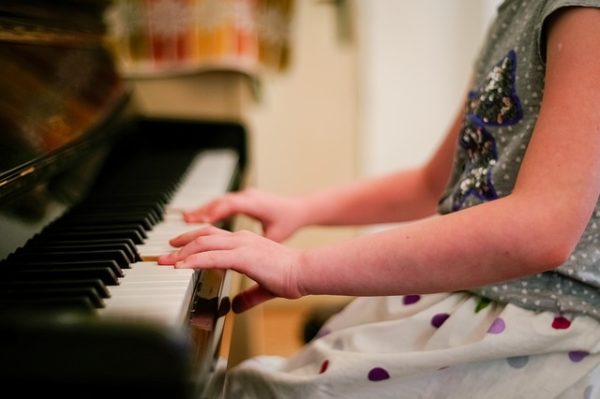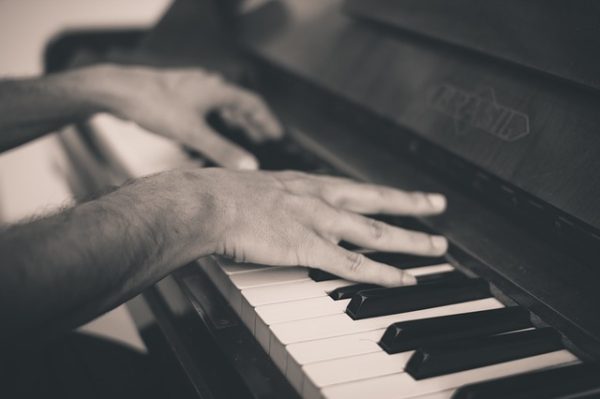アクセントとスタッカートが混同してしまうことは、誰しもあることです。
初めてそれぞれの楽譜記号の意味を知った時は、「へぇ~なるほど」となっても、いざ楽譜の中に出てくると、「あれ?どうやるんだっけ?」「アクセントってスタッカートと同じじゃない?」となってしまいますよね。
今回はそれぞれの違いと、それぞれの弾き方について説明します。

そもそもアクセントとスタッカートの意味は?
なんとなく「スタッカートは「ポンッ」と跳ねるように弾くこと、アクセントは強く弾くこと」というふうに覚えていませんか?
まずはそれぞれの意味をおさらいしてみましょう。
・スタッカートとは
![]()
音符を本来の長さより短く演奏することを指示する用語。音符の上又は下に(・)をつけて示す。又はstacc,の略号が使われる。
出典:音楽用語事典
意味を見るとわかるようにスタッカートは「「ポンッ」と跳ねるように弾くこと」ではなく、「本来の長さより短く演奏すること」なんです。
つまり「音の長さ」について指定している楽譜記号なのです。
・アクセントとは

「>」アクセントマーク(記号)の付けられた音を特に強調して演奏する。強調するというのは音量を上げること。その音を特に音量を大きく演奏するのだが、ピアノの場合は指の力(タッチ)、弦楽器の場合は弓のコントロール、管楽器の場合は息のスピードなどのコントロール、打楽器の場合は打つ力のコントロールが重要。どちらにしても上級テクニックではある。と言うことは初心者に難しいテックニック、なんとかアクセントをつけようとすると、それなりに悪戦苦闘することになる。でもこれによってメロディーが生き生きしてくることは受け合い。メリハリのある音楽にするためには重様な要素である。
出典:音楽用語辞典
少し長い文章ですが、文の最初に結論がありますね。
アクセントは「その音だけを強調して演奏することです。」
つまり「音の大きさ」について指定している楽譜記号です。
まとめると
スタッカート=音の長さを短く
アクセント=音の大きさを大きく
ですね。
では、実際にピアノで演奏する時、どのようにして弾き分けたら良いのでしょうか。

アクセントとスタッカートの弾き方とは
皆さんはアクセントとスタッカートを明確に引き分けることは出来ますか?
例えば、スタッカートを弾こうとしてその音を強く打ちすぎたり、逆に、アクセントを弾こうとしてその音をはねさせてしまったり、というような場合にはきちんと弾き分けができていないということになります。
スタッカートの弾き方
まず、スタッカートの持つ意味ですが、この記号がつく音符は長さを半分にすることを意識しましょう。
つまり、ただ音をはねさせるのではなく、四分音符なら八分音符に、八分音符なら十六分音符の長さで弾く必要があります。
この時、音を短くする、ということにとらわれ過ぎると高い場所から打鍵をして無駄にアクセントを付ける(音が大きくなる)ことになってしまいます。
手首から先を楽にして、指先で鍵盤を捉えると綺麗に音を切ることができます。
アクセントの弾き方
次に、アクセントの弾き方ですが、強く弾くことを意識しすぎると、スタッカートの時と同様に高い位置からの打鍵により音が切れてしまいます。
これは、腕の力だけで音の強さを上げようとしている非常に悪い例です。
特定の音を強く弾きたいのならば、全身を使って鍵盤に体重をのせると深みのある力強い音になります。
ちなみに応用ですが、スラーにアクセントがついている場合はどのように弾けばいいかわかりますか?
こちらも先ほどと同様に、全身を使って一音一音に力をこめると弾きやすいでしょう。
スラーがついているため、決して音を切ってはいけません。何度も練習しながら、体重のかけ方のコツを習得してくださいね。
肥田 says
良く分かりました。